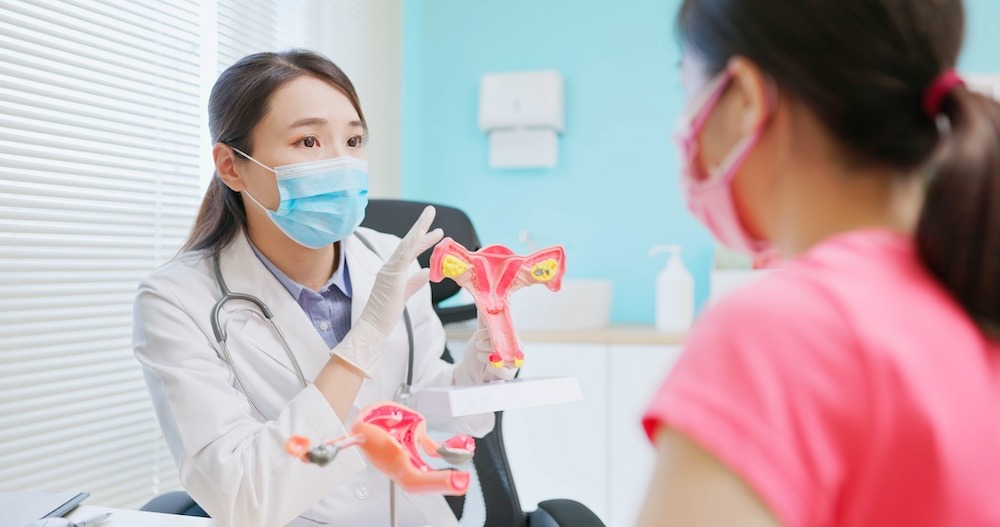
When thinking of types of cancer that affect women, breast cancer is usually at the top of the list. However, it's not the only cancer that affects women. It’s important also to be aware of gynecologic cancers that are related to the female reproductive system. There are several types of gynecological cancers. Four common ones women should know about are endometrial (uterine) cancer, ovarian cancer, cervical cancer, and uterine sarcoma.
Women should become familiar with these cancers, including the warning signs of each one. Detecting and diagnosing cancer early makes it easier to treat.
1. Endometrial Cancer
Endometrial cancer is the most common type of uterine cancer, affecting the tissue lining the uterus, called the endometrium. Some risk factors, such as age and obesity, are similar to those for ovarian cancer. However, there are some risk factors unique to endometrial cancer:
- Having type 2 diabetes
- Use of an IUD for birth control
- Using medications that affect hormones, such as tamoxifen, birth control pills, or estrogen replacement therapy
- A diagnosis of endometrial hyperplasia (thickening of the endometrium)
There are several symptoms of endometrial cancer, with the most common being abnormal vaginal bleeding. Other signs to be aware of include:
- Pain or difficulty during urination
- Pain during intercourse
- Pressure or pain in the pelvic area
Surgery to remove the uterus, called a hysterectomy, is a standard treatment for this type of cancer. Additional treatments may also be given depending on the stage of cancer and the patient’s situation. These treatments include chemotherapy, radiation therapy, hormone therapy, immunotherapy, and/or targeted therapy.
2. Ovarian Cancer
Ovarian cancer starts in the ovaries, and it is the second most common type of gynecologic cancer after uterine cancer. Common risk factors for ovarian cancer include:
- Family history of cancer: Having a close family member who has had ovarian, breast, or colorectal cancer raises your risk of developing ovarian cancer.
- Family cancer syndrome: About 25% of ovarian cancers are caused by an inherited genetic change, including hereditary breast and ovarian cancer syndrome (BRCA1 and BRCA2 mutations) and Hereditary nonpolyposis colon cancer, which also increases your risk for uterine and ovarian cancers.
- Weight: obesity or being overweight
- Late or no pregnancy: Women who had their first pregnancy after 35 or have never given birth have a higher risk of developing ovarian cancer. Pregnancy and breastfeeding reduce the risk of ovarian cancer due to less frequent ovulation.
- Hormone replacement therapy: Using estrogen or progesterone replacement therapy after menopause increases your risk of developing ovarian cancer.
There are no screening tests specifically for ovarian cancer. As a result, patients are often diagnosed with ovarian cancer at a later stage. Be on the lookout for symptoms of ovarian cancer, such as:
- Abdominal, lower back, or pelvic pain
- Abnormal vaginal discharge, especially after menopause
- Persistent bloating
- Frequent urination
- Feeling full despite not eating much
Tell your doctor if you're experiencing any of these symptoms. While they do not necessarily mean you have cancer, it’s important to look into the cause. Surgery to remove the ovaries is the most common treatment for ovarian cancer. Additional treatments, such as chemotherapy, radiation therapy, targeted therapy, and hormone therapy may also be needed. The gynecologic oncologist will consider the patient’s health, the stage of cancer, and the tumor size when determining the right treatment plan.
3. Cervical Cancer
Cervical cancer starts in the cells of the cervix, which is the lower part of the uterus. The primary cause of cervical cancer is HPV infection.
There are two main types of cervical cancer: squamous cell carcinoma and adenocarcinoma. Squamous cell carcinoma accounts for about 90% of all cervical cancers. It begins in the cells of the outer part of the cervix (called the ectocervix) that leads to the vagina. Adenocarcinoma, on the other hand, starts in the glandular cells located in the opening of the cervix (called the endocervix).
Some signs of cervical cancer include:
- Vaginal bleeding after sex
- Vaginal bleeding after menopause
- Vaginal bleeding between periods or having periods that last longer than usual
- Pain during intercourse
- Abdominal pain
- Fatigue
- Watery or bloody vaginal discharge with a strong odor
- Swelling in the legs
- Dull and persistent back pain
- Painful urination or blood in the urine
- Painful, bloody bowel movements
Many women avoid experiencing symptoms of cervical cancer thanks to Pap screening tests. A Pap test is part of the annual gynecologic exam. Your gynecologist usually performs an HPV test at the same time as the Pap test, to check for an active HPV infection. This is because some strains of HPV infections are the known cause of cervical cancer. If you’re positive for HPV, you need to be sure you stay on top of screening tests and report any symptoms as soon as possible to your doctor so they can look into the cause.
Related blog: Understanding the Connection Between HPV and Cervical Cancer
Treatments for cervical cancer are similar to other types of gynecologic cancers, with surgery being one of the most common first steps. For cervical cancer, a hysterectomy is often used to remove the uterus and cervix. After surgery, additional therapies are often used to ensure all cancer cells are destroyed.
4. Uterine Sarcoma
Uterine sarcoma is a type of uterine cancer, but it is less common than endometrial cancer. It develops in the muscles that support the tissues of the uterus.
Risk factors for uterine sarcoma include:
- Race: African-American women are more likely to develop uterine sarcoma than women of other races.
- Prior cancer treatment: Receiving prior treatment for other cancers can increase the chance of developing uterine sarcoma. Radiation therapy to the pelvis or taking tamoxifen for breast cancer are examples of this.
- Retinoblastoma: Women who have retinoblastoma (a form of eye cancer) as children are at increased risk of developing uterine sarcoma.
Here are some signs of uterine sarcoma:
- Abnormal vaginal discharge
- Unusual vaginal bleeding (including after menopause)
- Pelvic pain or a palpable mass in the pelvis
- Abdominal pain
- Changes in appetite or unexplained fullness
Treatment for uterine sarcoma typically starts with surgery to remove the uterus, fallopian tubes, and sometimes the ovaries as well. Removing the ovaries depends on whether the patient is post-menopause. Depending on the stage, additional therapies may be necessary. Stage II - Stage IV uterine sarcoma is usually treated with chemotherapy after surgery. Radiation therapy may also be used if the cancer is localized. These treatments are used to ensure all cancer cells are destroyed.
Diagnosing Gynecological Cancers
If you are experiencing symptoms and your doctor suspects you may have gynecological cancer, several tests can be run.
- A CA-125 test can be used to see if there are elevated levels of this protein in the blood. This can mean that ovarian or endometrial cancer is present, and more testing should be done.
- Imaging tests such as an MRI or PET-CT scan to look for signs of cancer.
- A biopsy, a colposcopy, and/or an endoscopy will allow the doctors to study samples of tissue for signs of cancer.
If cancer is found, you will need to visit a gynecologic oncologist. These specialists have the training and experience to create the right treatment plan for you.
Related blog: Signs and Symptoms of Gynecologic Cancer You Shouldn’t Ignore
Gynecologic Cancer Care in the Albany, New York Region
Knowing what’s normal for your body can help detect gynecologic cancers as early as possible. Plus, the Pap test for cervical cancer is a well-established tool for screening and identifying cervical cancers as they develop. Early detection increases the likelihood of successful treatment.
If you or a loved one has recently received a diagnosis of gynecologic cancer, the gynecologic oncologists at New York Oncology Hematology are here to help. We will create a personalized treatment plan for you. Find a location in the Capital District and request a consultation. We have locations throughout Albany, Troy, Amsterdam, Clifton Park, and Hudson, New York.

